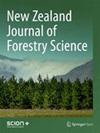Measuring harvest residue accumulations at New Zealand’s steepland log-making sites
IF 1.1
4区 农林科学
Q2 FORESTRY
引用次数: 0
Abstract
Background: When harvesting plantation forests of Pinus radiata (D.Don) in New Zealand, large residue piles commonly accumulate on or adjacent to processing sites. While the merchantable volume that is transported to market is carefully measured, little is known of the quantity of the piled, residual material. A working knowledge of residues is becoming more important as it is not only a potentially merchantable product for the bioenergy market, but when stored in perpetuity it can present a risk of self-ignition, and specifically on steep slopes, it presents a mobilisation risk if not stored correctly. Methods: The area, bulk volume and depth of residue piles at 16 recently harvested steepland sites were measured from a wide geographic spread across New Zealand. Unmanned Aerial Vehicle imagery was used to build georeferenced photogrammetric models of residue piles (94 per cent of the studied volume). Pile area was determined from interpreting boundaries from orthophotos and volumes determined by interpolating the obscured terrain surfaces on duplicate photogrammetric models. The remaining 6 per cent of pile volume was measured with handheld GPS tracking of the perimeters and on-site estimation of average pile depth. Results: For a mean harvest area of 18.9 ha, there was a mean of 2.4 piles per harvest site, 2600 m3 bulk volume and 2900 m2 of area covered. For every hectare harvested, a bulk volume of 170 m3 is piled at the landing, or alternatively, 0.23 m3 of bulk pile volume per tonne harvested. The manual terrain interpolation methodology was tested against collecting georeferenced pre-harvest terrain surfaces, yielding an average difference of 19% across two sites and six residue piles. Conclusions: This research demonstrates the ability to investigate the bulk volume and site coverage of landing residue piles with equipment and software tools available to today’s forester. Mean values for pile area and volume are presented to reflect the current state of knowledge and can be a reference point for future initiatives.测量新西兰陡坡伐木场的收获残留物堆积
背景:在新西兰收获辐射松(D.Don)人工林时,通常会在加工场地上或附近堆积大量残留物。虽然运往市场的可销售数量是经过仔细测量的,但人们对堆放的剩余材料的数量知之甚少。残留物的实用知识变得越来越重要,因为它不仅是生物能源市场上潜在的可销售产品,而且当永久储存时,它可能会存在自燃风险,特别是在陡坡上,如果储存不正确,它会存在动员风险。方法:在新西兰各地广泛分布的16个最近收获的陡坡地测量残留物堆的面积、体积和深度。无人机图像用于建立残桩的地理参考摄影测量模型(占研究体积的94%)。桩面积是通过解释正射影像的边界来确定的,体积是通过在重复的摄影测量模型上插值模糊的地形表面来确定的。剩余6%的桩体积是通过手持GPS跟踪周长和现场估计平均桩深来测量的。结果:平均收获面积为18.9公顷,每个收获点平均有2.4根桩,体积为2600立方米,覆盖面积为2900平方米。对于每收获一公顷,在着陆处堆积170立方米的体积,或者,每吨收获0.23立方米的体积。手动地形插值方法针对采集地理参考的收获前地形表面进行了测试,在两个地点和六个残桩之间产生了19%的平均差异。结论:这项研究证明了利用当今林业工作者可用的设备和软件工具调查着陆残留物堆的体积和场地覆盖率的能力。桩面积和体积的平均值反映了当前的知识状态,可以作为未来计划的参考点。
本文章由计算机程序翻译,如有差异,请以英文原文为准。
求助全文
约1分钟内获得全文
求助全文
来源期刊

New Zealand Journal of Forestry Science
FORESTRY-
CiteScore
2.20
自引率
13.30%
发文量
20
审稿时长
39 weeks
期刊介绍:
The New Zealand Journal of Forestry Science is an international journal covering the breadth of forestry science. Planted forests are a particular focus but manuscripts on a wide range of forestry topics will also be considered. The journal''s scope covers forestry species, which are those capable of reaching at least five metres in height at maturity in the place they are located, but not grown or managed primarily for fruit or nut production.
 求助内容:
求助内容: 应助结果提醒方式:
应助结果提醒方式:


